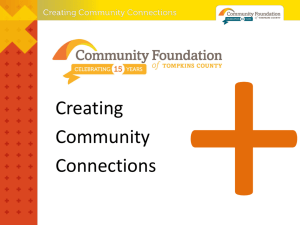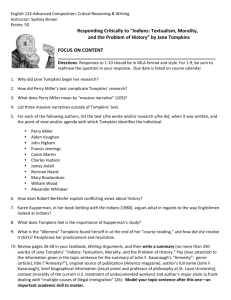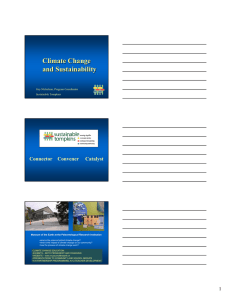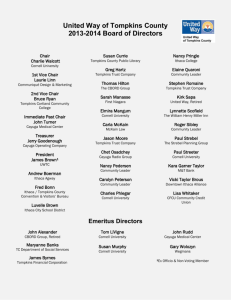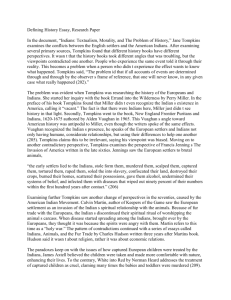From Business Strategies to Operations How to Align Execution with Strategic Plans Gene Tyndall
advertisement
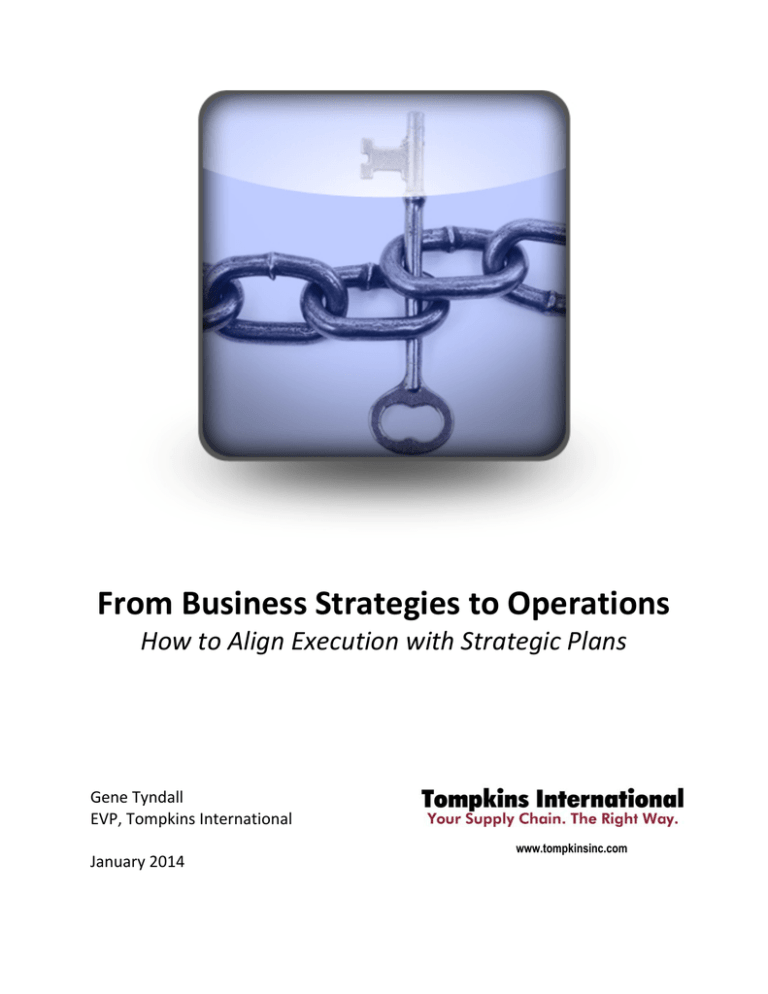
From Business Strategies to Operations How to Align Execution with Strategic Plans Gene Tyndall EVP, Tompkins International January 2014 www.tompkinsinc.com Table of Contents Introduction and Purpose 3 What is Operations Strategy, Really? 4 Three Steps to Developing the Right Operations Strategy 5 Step 1: Determine the AS‐IS 6 Step 2: Engage in an “Advanced Solutions Workshop” (ASW) 7 Step 3: Launch and manage initiatives that align with strategies 11 Summary and Conclusion 14 © Tompkins International, How to Align Execution with Strategic Plans | 2 Introduction and Purpose Achieving clear and sustained alignment between operations execution and the plans emanating from business strategies is challenging. Many executives understand the complexities involved, but they are concerned that 90% of business strategies are not implemented as intended.1 The recent Tompkins paper, “Employing Available Capital Wisely,” emphasizes the strong and compelling rationale for investing in a company’s operations. While executives have several options for employing capital (including holding it in safe havens such as offshore banks) when free cash flows are healthy, and the company is earning impressive levels, the time for improving the performance of operations is now. Tompkins has also published videos and thought leadership pieces focused on the timely issue of the significant growth of online ordering, and the serious threats by the “titans” (Amazon and Walmart) as they expand their product lines into both consumer and business needs. There are few companies, or industries (if any), that will not be impacted by Amazon, as it continues to expand its business model. These videos by the CEO of Tompkins International, Jim Tompkins, provide business leaders with insights to generate their own “counter‐offensives.”2 The videos and other collateral by Tompkins provide educational tools for the executive suite as they are beginning to understand that supply chains are about more than logistics and the buying and selling of goods; they are about competitive differentiation and profitable business growth. Still, executives are concerned with alignment and how execution can best be used as an enabler of business strategies rather than an inhibitor. Common questions asked by these executives include: • Our operations and supply chains are not dynamic or flexible enough to change with our new strategies. What should we do? • We often set targets for margin improvements that our supply chains cannot meet. How can we perform better? • Our business strategies are focused better than ever on our markets and our products, but our operations do not differentiate us from competitors, thus we fight to hold our share. Aren’t there ways to compete with operations? • Our organization hampers our strategies. How can we get departments to work together better? • Why is it that our inventories are either too high or often in the wrong stocking locations, and we incur high costs just to meet demand? Can’t we better align our sales and operations processes? How do we become more demand‐driven? © Tompkins International, How to Align Execution with Strategic Plans | 3 This paper addresses these questions, as well as others that are associated with better aligning operations with strategies so that overall business performance is enhanced. Also included are some guidelines and methods that have proven to be very helpful for bridging the gaps between strategies and operations, and between planning and execution. What is Operations Strategy, Really? There is no shortage of literature, education, training, webinars, and entire conferences devoted over the years to the development and formulation of business strategy, as well as the strategic planning that goes along with it. It is difficult if not impossible to come across any business that does not have some process in place for determining its products and its target markets. Common questions for every board, C‐level executive, and shareholder include: “What should be our vision and mission, and what should we sell, and to whom?” Until recently, however, there has been little, if any, attention given to the strategies for “operationalizing” these business strategies. It has been largely taken for granted that the operations managers of the business would do their jobs well, and their functions would be managed adequately. Several events, however, have altered this expectation, including: • Complexity: As businesses have expanded, regulations have widened, and volumes have increased, so have complications. • Volatility: As products and customers have expanded, so have choices, so that risks and uncertainties have become prevalent. • Differentiation: As competitors have entered the markets, so has the need for differentiation. Why will customers buy from us? • Sales and Marketing Channels: The Internet has “changed everything.” • Speed to Act: As lead times have lengthened for product acquisition, customers demand more now, so there is conflict in nearly all functions or business processes. How do we become more demand‐driven when we are supply‐challenged? The need for an operations strategy has come about, in large part, to address these events and influences. Unless companies have a well‐defined and comprehensive strategy for operations, they will fail to enable the business strategies to be achieved effectively and efficiently. Tompkins’ operations strategy provides the “bridge” between business strategies and business performance. This bridge is more than a link or a path; rather, it is a set of “capabilities.” It includes choices about operational matters—logistics networks, inventory policies, channel management, customer service levels, and more. © Tompkins International, How to Align Execution with Strategic Plans | 4 At its basic sense, business strategies are about three distinct choices: • What businesses should we be in, and what products will we sell? • Who will we target to sell these to? • Why will they buy our products? At its basic level, then, operations strategies are about: • What capabilities do we need to deliver these products to these markets efficiently and effectively, so that the business strategies will be achieved? Figure 1: Managing a Strategy to Achievement Thus, operations strategy is determining “how” companies will operate their supply chains and their customer services to achieve business goals and strategies. This involves major decisions about assets, locations, processes, people, technologies, and inventory policies. In effect, it aligns the execution capability with the strategies. It is important, also, to separate the necessities from the differentiators. Companies need basic capabilities just to be able to compete within its industry. The Mega Processes of supply chains illustrate this point well. If a company deals with products, it must have some capabilities for PLAN – BUY – MAKE – MOVE – DISTRIBUTE – SELL, whether it performs these processes in‐ house or outsources to selected service providers. Further, it needs basic capabilities for support, such as information technology, back‐office functions, HR, sales and marketing. © Tompkins International, How to Align Execution with Strategic Plans | 5 When the company seeks differentiating capabilities in order to outperform competitors, operations planning becomes most interesting and challenging. Operations strategies also take on added importance. Determining how best to compete on operations, and the right initiatives to achieve and sustain advantages, are matters of strategic choice. Developing the right operations strategy for the business is the right challenge. Three Steps to Developing the Right Operations Strategy In working with hundreds of companies over the years, Tompkins has observed numerous examples of operations strategies, ranging from virtually none at all, to an operations strategy for each supply chain function (e.g., a transportation strategy, distribution center strategy, and a sourcing strategy). Until recent times, however, with the advent of multichannels, few companies have developed cross‐functional capabilities according to a well‐defined operations strategy. Getting into multichannels—led by unprecedented growth in e‐commerce, but also fueled by separated business units—has changed the game. Customers are being served both by direct retail and wholesale, as companies diversify. Online ordering, whether for B2B or B2C, has created new markets, with new challenges. And, demands are rapidly exceeding capabilities. The pressure to execute effectively has increased, even for the necessary capabilities. With this are issues of decision rights, roles and responsibilities, organizational structures, and operating models. Figure 2: Tompkins Core Competency: Supporting Strategy‐to‐Execution © Tompkins International, How to Align Execution with Strategic Plans | 6 Operating models involve the degree of business process integration and standardization for delivering goods and services to customers. And these models can be categorized as diversification, coordination, replication, and unification. As such, the operating model drives the foundation for execution, which, in turn, drives the business processes, decision rights, and IT infrastructure. Determining the right operating model is, therefore, a critical step in the development of the right operations strategy. With these principles and challenges in mind, Tompkins has developed and tested the following three‐step process for companies to develop the right operations strategy. Since the issues and challenges are complex, the steps are not simple; however, following them with the right events and tools leads to not only the right strategies, but also to the right path to superior execution and performance. Step 1: Determine the AS‐IS state. There is no substitute for what has been proven over and over again: A company cannot get to a vision, or a preferred state, without fully understanding its current state. Knowing and validating its operational performance, its operational capabilities, its strengths, weaknesses, opportunities, and threats (SWOT), and its competitive positioning, are all essential elements of the starting point. Determining the AS‐IS should be done with both a structured and intangible assessment methodology. The structured methodology consists of process mapping, supply chain mapping, technology mapping, and performance analyses. The key measures of costs, time, and quality are identified, and these are best benchmarked against industry segment leaders. The intangible methodology consists of unbiased assessments of the organization, the people, and the current capabilities. What the company is capable of doing beyond its current levels of performance is critical when alternatives are next identified. There are two most useful work products of the AS‐IS step. One is a SWOT analysis—the clear and unbiased representation of the company’s strengths, weaknesses, opportunities and threats. The second is the design of an executive workshop (described in step #2) that is focused on the needs and opportunities of the business, when aligned with the business strategies (i.e., the products to be sold, their value propositions, and the target markets). This is the connection to the discussion above about what operations strategies are and why they matter. Formulating the “right” operations strategy for the business is the goal of the next step. © Tompkins International, How to Align Execution with Strategic Plans | 7 Figure 3: Advanced Solutions Workshop Step 2: Engage in an “Advanced Solutions Workshop” (ASW). As discussed earlier, Tompkins observes numerous companies that do not have a common understanding of how best to align business strategies with execution; they may have mixed and sometimes conflicting objectives among departments or units, or have inadequate achievement of strategic plans or business goals. Often these companies are conducting innumerable meetings, producing many individual reports, and are even finding themselves “stuck” in complexities or uncertainty. Tompkins has adopted a special process, and event, to resolve these common challenges, and it is yielding significant results for those companies that have employed it. The “Advanced Solutions Workshop” (ASW) is based on proven methods and techniques that evoke “group genius” to determine the right operations strategy for the particular business. The belief is that adequate knowledge most often exists within the company; however, it is often not harnessed around the right issues and challenges, viewed and dealt with as integrated solutions, or focused on the right challenges. © Tompkins International, How to Align Execution with Strategic Plans | 8 Figure 4: The Model for SCAN, FOCUS, and ACT The AS‐IS analysis in step #1, includes the customization of the workshop design. The workshop agenda is built around three phases: 1. Scan: looks externally and internally for relevant ideas 2. Focus: employs several group genius techniques to iterate toward the preferred outcome 3. Act: determines the path forward, or roadmap, for achieving the right operations strategy, and thus, the alignment with the business strategy Determining the important capabilities needed for the new operations strategy is a critical success factor of the ASW. The “differentiating capabilities” enable the company to best compete on operations. These provide the “how to win” factors, inasmuch as in reality supply chains compete, not companies. Too much effort on basic capabilities, or the necessities, detracts from the more important differentiators, which must be aligned with the business goals of profitable growth from selling more products in the target markets. Procter & Gamble has often led its markets with innovation, both in products and in services. One of its focused programs has been on changing R&D to “C&D” (connect and develop). Working and collaborating with customer retailers, P&G has developed new product‐service bundles, such as “the perfect order” and other cross‐functional customer‐driven measures, that differentiate them from competitors. This, in turn, has led to more demand‐driven practices, in which P&G has continued its differentiating capabilities. © Tompkins International, How to Align Execution with Strategic Plans | 9 Determining the right capabilities has other benefits. When a company formulates its strategic agenda, it typically defines its value propositions for its products and its target markets. Determining “where to play” and “how to play” are deliberate choices—and they must be turned into action. Whereas the first step toward action may be “resource allocation” (i.e., assigning people and capital to initiatives that matter), strategic priorities often shift, progress is often mixed, targets are omitted, distractions disturb the focus, and the result is all too often lacking the right capabilities. The operating model can serve as an illustration of this problem, or gap. An operating model may be defined as “the most effective standardization and integration of business processes for providing goods and services to customers.” It describes how a company wants to thrive and grow, and according to many online sources, it “drives the design of the foundation for execution.” Thus, it is not difficult to note that without a clear operating model, execution can take many directions, and the wrong capabilities can easily result. While organizational design is beyond the scope of this paper, it is important to acknowledge that the right operating model often impacts the organizational structure. Aligning the organization with the business strategy is complex and requires assessments and organizational design methods that depend on knowledge about how organizations work and are impacted by cultural differences. Figures 5‐6 show the factors that are considered when alignment needs to be challenged and possibly redesigned. Figure 5: Alternative Ways to Define Organizations © Tompkins International, How to Align Execution with Strategic Plans | 10 Figure 6: Summary of Organizational Models Most often, however, the new operating model will require redefining roles and responsibilities, as well as associated decision rights. As the preferred operating model is debated and selected, the changes in roles and responsibilities, and decision rights should be identified and either redefined or included in the roadmap for achieving the new strategy. The best and most current example of this challenge is the increasing need for “multichannel operations excellence” (MOE). As companies expand their sales channels, especially for online ordering, operating models become mandatory. Customers are often served by the multiple channels differently, which damages loyalty and sales. Most companies strive for “omnichannel” operations, in which all channels operate equally well for the customer experience. Yet, issues such as “distributed order management” (DOM) (or where should the product order be fulfilled from), serve to limit execution excellence. For this reason and due to the need for great customer personalization, Tompkins has moved beyond omnichannel to “Personalized Omnichannel Operations.” Again, capabilities are the critical success factor in customer service. © Tompkins International, How to Align Execution with Strategic Plans | 11 Figure 7: Omnichannel Creates Complex Supply Chains The development and choice of the right operations strategy, and thus, the right capabilities (especially those that differentiate), are the important products of step #2, along with the right path forward and roadmap to achieve them. While it is complicated to derive the right strategy for the company, the ASW provides a unique experience and event to determine and design the future operations to be closely aligned and enable the business strategy. Without such a process, company leaders struggle with direction, consensus buy‐in, and sustained leadership of the right initiatives, and thus, the right operating model and execution. Step 3: Launch and manage initiatives that align with strategies. Once the ACT phase of the ASW is concluded, companies have the right path forward, and the roadmap, to achieve the operations strategy. Most of the time this includes building the right capabilities that will enable the strategic goals. Thus, in this step, companies launch and manage multiple initiatives, or projects, that align with the strategy and yield the right capabilities. Program management is the management of multiple projects so that they are all completed on time, on budget, and in sync with each other. This is a recognized discipline with well understood skill requirements, although companies often have competent project directors, but not effective program managers. Yet, the successful completion of each project may not satisfy the objectives of the program. © Tompkins International, How to Align Execution with Strategic Plans | 12 The space program has illustrated this point for years. The success of the Space Exploration Program, and other NASA achievements, was due in large part to effective program management; problems with defense and domestic programs are often due to weaknesses in program management. Another key challenge, along with program management, is change management. All too often changes are not addressed sufficiently, or are not a committed priority, and the execution either performs less than satisfactorily, or reverts back to the “old ways.” It is critical that change management is an integral part of the program and that it employs new methods that are proven to work. Figure 8: Organizational Design and Change Management Figure 9: Three‐Phases of Organization Design © Tompkins International, How to Align Execution with Strategic Plans | 13 Figure 10: Span of Change Management Defining the path forward and developing a roadmap, within the ACT phase of the ASW, are often viewed as nothing short of amazing. When management teams can come together, engage their group genius, and reach agreement on the right “TO‐BE” process (i.e., defining and documenting) and the initiatives to enable that, in a few days, not only is substantial time reduced, but sustained commitment is assured. One CEO of a consumer goods company remarked, “How exciting! I was able to accomplish in three days what would have normally required three months or more.” Thus, the ASW produces the right operations strategy and capabilities needed; the next requirement is the effective program management processes alluded to above. Following the roadmap is critical for success. Summary and Conclusion This paper has described the needs and challenges in aligning execution with strategic plans, along with the preferred approach and solutions methods. These are being proven on a regular basis for those companies that truly want to differentiate and be successful. Tompkins knows from experience and benchmarking that a company competes well and grows profitably, regardless of its industry, when it employs the ASW solution to do the following: • Help formulate its preferred operations strategy • Define its best operating model • Determine its best roadmap for success © Tompkins International, How to Align Execution with Strategic Plans | 14 Tompkins is proud to be helping select companies employ these solution methods, raising their level of competitive differentiation. The journey to becoming truly demand‐driven is best planned and designed before it begins. 1. 2. Read: a. “Employing Available Capital Wisely,” by Tompkins International: http://www.tompkinsinc.com/white‐ paper/2013/employing‐available‐capital‐wisely/ b. Strategy Maps, Robert Kaplan and David Norton, 2004: http://www.amazon.com/Strategy‐Maps‐ Converting‐Intangible‐Tangible/dp/1591391342 Tompkins International Videos: a. Facing the Titans: http://www.tompkinsinc.com/titans/ b. The Amazon Cure to the Plague of Short‐Term Thinking in Business: Bezos Gets it Right: http://www.tompkinsinc.com/videos/2013/the‐amazon‐cure‐to‐the‐plague‐of‐short‐term‐thinking‐in‐ business‐bezos‐gets‐it‐right/ c. The Amazon Effect: http://www.tompkinsinc.com/amazon‐effect/ Contact Information Tompkins International info@tompkinsinc.com About Tompkins International Tompkins International transforms supply chains for value creation. For more than 35 years, Tompkins has provided end‐to‐end solutions on a global scale, helping clients align business and supply chain strategies through operations planning, design and implementation. The company delivers leading‐edge supply chain solutions by optimizing the Mega Processes of PLAN‐BUY‐MAKE‐MOVE‐STORE‐SELL. Tompkins supports clients in achieving profitable growth in all areas of global supply chain and market growth strategy, organization, operations, process improvement, technology implementation, material handling integration, and benchmarking and best practices. Headquartered in Raleigh, NC, USA, Tompkins has offices throughout North America and in Europe and Asia. For more information, visit www.tompkinsinc.com. © Tompkins International, How to Align Execution with Strategic Plans | 15
